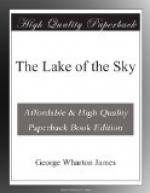moraine slope. The materials, also, which
may be examined with ease through the wonderfully
transparent water, are exactly the same as that composing
the moraine, viz: earth, pebbles, and bowlders
of all sizes, some of them of enormous dimensions.
It seems almost certain that the margin of
the great Lake Valley glacier, and of the Lake
itself when this glacier had melted and the tributaries
first began to run into the Lake, was the series
of rocky points at the head of the three little lakes,
about three or four miles back from the present
margin of the main Lake; and that all lakeward
from these points has been filled in and made
land by the action of the three glaciers described.
At that time Rubicon Point was a rocky promontory,
projecting far into the Lake, beyond which was another
wide bay, which has been similarly filled in by debris
brought down by glaciers north of this point.
The long moraines of these glaciers are plainly
visible from the Lake surface; but I have not
examined them. Thus, all the land, for three
or four miles back from the Lake-margin, both north
and south of Rubicon Point, is composed of confluent
glacial deltas, and on these deltas the moraine
ridges are the natural levees of these
ice-streams.
e. Parallel Moraines. The moraines described above are peculiar and almost unique. Nowhere, except about Lake Tahoe and near Lake Mono, have I seen moraines in the form of parallel ridges lying on a level plain and terminating abruptly without any signs of transverse connection (terminal moraine) at the lower end. Nor have I been able to find any description of similar moraines in other countries. They are not terminal moraines, for the glacial pathway is open below. They are not lateral moraines, for these are borne on the glacier itself, or else stranded on the deep canyon sides. Neither do I think moraines of this kind would be formed by a glacier emerging from a steep narrow canyon and running out on a level plain; for in such cases, as soon as the confinement of the bounding walls is removed, the ice stream spreads out into an ice lake. It does so as naturally and necessarily as does water under similar circumstances. The deposit would be nearly transverse to the direction of the motion, and, therefore, more or less crescentic. There must be something peculiar in the conditions under which these parallel ridges were formed. I believe the conditions were as described below.
We have already given reason to think that the original margin of the Lake, in glacial times, was three or four miles back from the present margin, along the series of rocky points against which the ridges abut; and that all the flat plain thence to the present margin is made land. If so, then it is evident that at that time the three glaciers described ran far out into the Lake, until reaching deep water, where they formed icebergs. Under these conditions, it is plain




